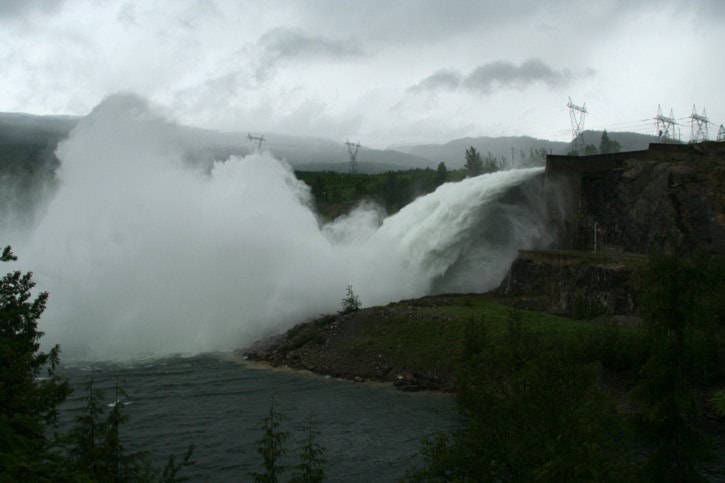The Revelstoke Dam provided a Father’s Day spectacle as it gushed water over its spillway.
The event attracted a steady stream of visitors who gathered to take photos and video of the massive torrent of water.
BC Hydro had warned of impending spilling in May.
In a May 18 email, BC Hydro spokesperson Dag Sharman told the Times Review that the Revelstoke Dam reservoir was “quite low” and absorbing runoff.
“The risk of spill is heightened because of province-wide high snowpack and expected high water inflows into our reservoirs, low domestic demand, and negative export prices,” he wrote.
Sharman said the planned spills were related to requirements to maintain minimum flows to benefit fish and wildlife habitat. That amounts to a minimum of 142 cubic metres per second.
Revelstoke-based Hydro spokesperson Jennifer Walker-Larsen said the Revelstoke Dam reservoir has filled up and is now about 15 centimetres below full pond. The dam spillway is being used to pass inflows from rain and snowmelt. On Sunday, the dam spilled at a peak rate of about 24,000 cubic feet per second, in addition to generating electricity. Spilling will continue this week at a reduced rate of about 10,000 cubic feet per second. On average, inflows into the reservoir in June are about 24,000 feet per second. Last week, rain and snowmelt caused inflows to peak at 42,000 cubic feet per second and average 33,000 cubic feet per second.
In May, NDP Opposition critics claimed that energy policies imposed by the B.C. Liberal government had forced BC Hydro to spill water at the Peace Canyon Dam because the Crown corporation was contractually obliged to purchase power from Independent Power Producers, creating a surplus of much cheaper traditional dam power.
“B.C. Hydro had no choice but to spill more than 800 million cubic feet of water over the dam because they had to fulfill the contracts with private producers,” said NDP energy critic John Horgan. “This is exactly the situation Adrian Dix and B.C.’s New Democrats have been raising for many years. The Liberals are putting their friends’ business interests ahead of the public interest. The result is rate increases of 36 per cent over five years, with more to come.”
Horgan cited documents submitted to the B.C. Utilities Commission by BC Hydro that showed Hydro was buying high and selling low during the windfall spring runoff period when firm, traditional Hydro was plentiful.
“The document shows B.C. Hydro will purchase 802 GWh in April 2012, 1,018 GWh in May, and 1,087 GWh in June from IPPs at an average cost of about $68/MWh,” Horgan wrote. “During the same three-month period, the average price to purchase power on the open market is approximately $10.”
“We’re buying at $68 when the electricity is only worth $10,” he stated. “With the massive volume of electricity we’re buying at those prices, it adds up to about $180 million that B.C. Hydro is overpaying in just a three month period.”
Hydro spokesperson Dag Sharman said the spilling at the Revelstoke Dam was a balancing act: “During both high and low water years, BC Hydro must balance supply and demand in the province. Energy supplied by IPPs at the price set in their long-term contracts assists in providing that balance.”
The electrical market is extremely complex; it’s virtually impossible to pin a cause-and-effect relationship on any particular incident as dams are operated based on a complex set of variables. Opposition critics, however, have claimed there is a direct relationship between spilling and IPP purchases this season.
